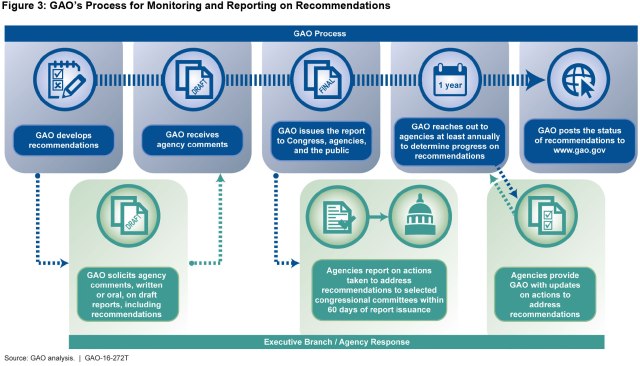Getting Closure on Our Recommendations
 (Excerpted from GAO-16-272T)
(Excerpted from GAO-16-272T)
- Increase savings and revenues. With a program as large as Medicare—$603 billion in 2014—closing just one of our recommendations on its payment policy could have saved an estimated $3.2 billion to $5.1 billion from 2010 through 2012. The Navy’s roughly $34 billion Littoral Combat Ships haven’t completed key tests such as shock trials, which evaluate the ships’ vulnerability to underwater explosions. We recommended delaying funding pending more tests, which could save money and produce a better ship—and the Secretary of Defense recently directed the Navy to cut production. And if the IRS had the authority to correct more taxpayer errors as we recommended, that could raise $133 million through 2025, according to the Joint Committee on Taxation.
- Enhance services to the public. Chicken and turkey products contaminated with pathogens cause more U.S. deaths than any other food products. In 2014, we found that the U.S. Department of Agriculture didn’t have performance measures with targets for all poultry products, such as ground chicken, to help reduce illnesses caused by pathogen contamination. To help ensure food safety, we recommended that USDA develop certain performance measures—and USDA agreed. However, measures and targets have yet to be established, limiting what information is available to the public and reducing oversight and accountability.
- Improve federal programs. IT security seems to be a feature of modern life and, since 2010, we have made around 2,000 recommendations to improve federal cybersecurity, but about 840 of recommendations remain open. For example, we recommended that the Office of Management and Budget address agency cyber incident response practices in its oversight of agency information security programs. Implementing this and other outstanding recommendations could better protect federal data and federal agencies’ responses to cyberattacks and data breaches.
- Questions on the content of this post? Contact Chuck Young at youngc1@gao.gov.
- Comments on the WatchBlog? Contact blog@gao.gov.

GAO's mission is to provide Congress with fact-based, nonpartisan information that can help improve federal government performance and ensure accountability for the benefit of the American people. GAO launched its WatchBlog in January, 2014, as part of its continuing effort to reach its audiences—Congress and the American people—where they are currently looking for information.
The blog format allows GAO to provide a little more context about its work than it can offer on its other social media platforms. Posts will tie GAO work to current events and the news; show how GAO’s work is affecting agencies or legislation; highlight reports, testimonies, and issue areas where GAO does work; and provide information about GAO itself, among other things.
Please send any feedback on GAO's WatchBlog to blog@gao.gov.
